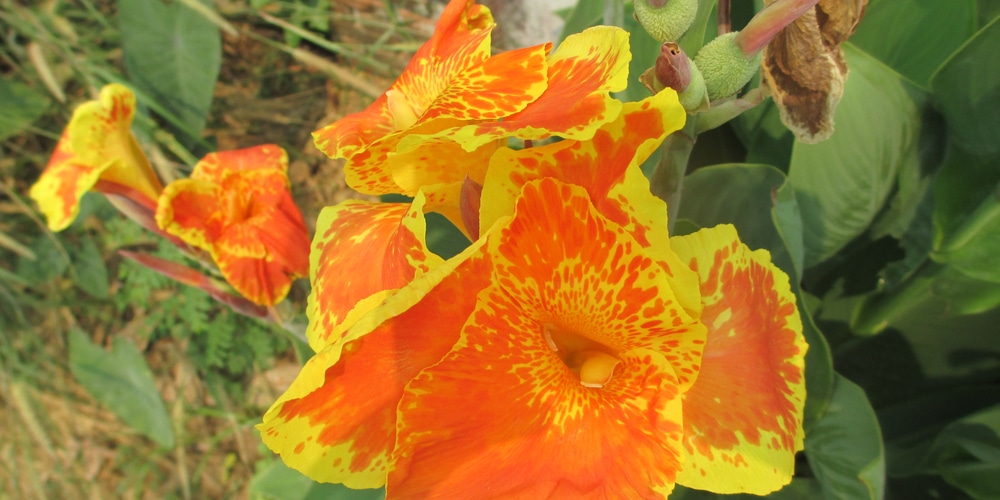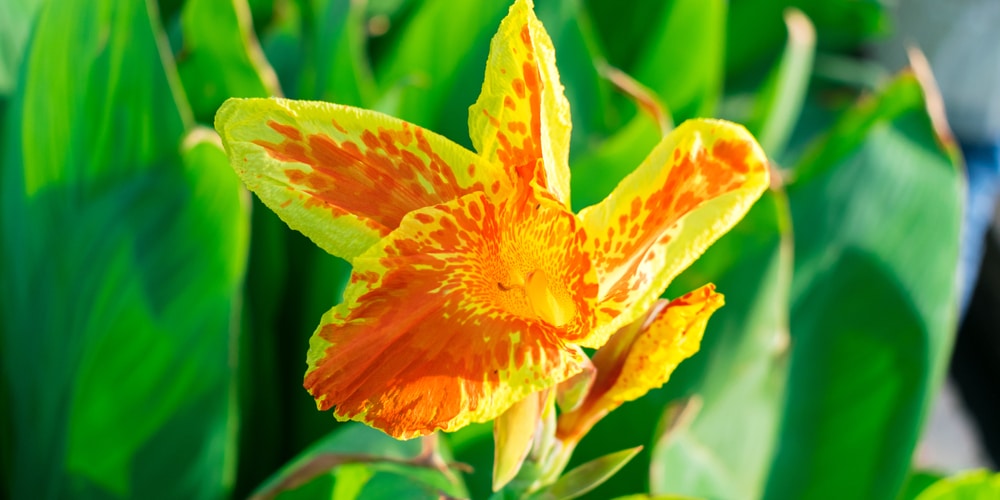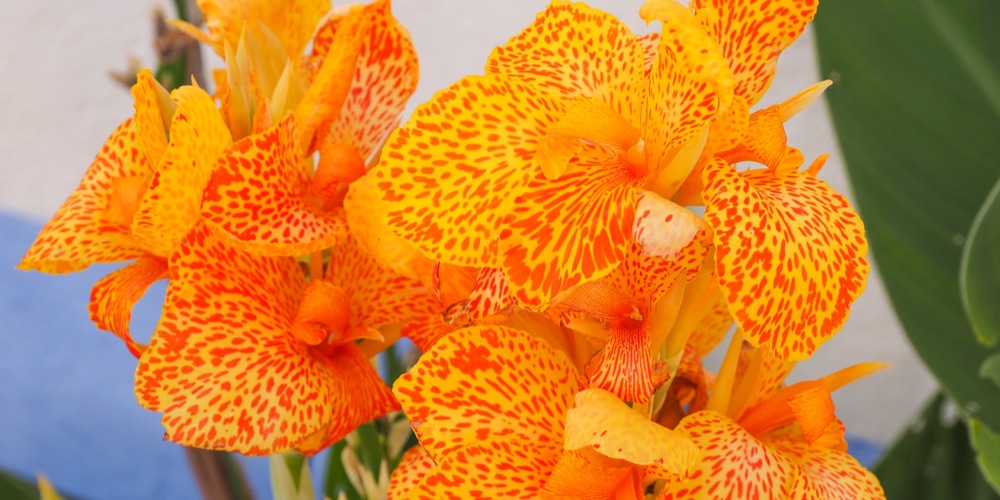Canna Cleopatra is an eye-catching addition to any garden or landscape. Like all the genera of canna, it has large, exotic flowers that come in varieties of vibrant colors such as red, yellow, and orange. The leaves are also large and textured, adding interest and contrast to the plant. Canna Cleopatra is a reliable bloomer, producing flowers from early summer through fall.
Good news because this plant is also easy to care for. If these lilies are grown near the edge of a pond or lake, water is not necessary. If bodies of water are not available, you can plant Canna Cleopatra in a spot where full sun is received.
With its colorful blooms and low maintenance requirements, it’s no wonder that Canna Cleopatra is such a popular choice among gardeners.
| Botanical Name | Canna Lily |
| Common Name | Canna Cleopatra |
| Plant Type | Perennial |
| Flower Color | The flower is usually yellow with red stripes running towards the center and a bright orange blotch in the center. |
| Size When Mature | 3 to 4 inches |
| Bloom Time | Summer to Middle of Fall |
| Sun Requirements | Full Sun |
| USDA Hardiness Zones | 8 – 11 |
| Soil PH Range | 6.0 – 7.0 |
| Soil Type | Neutral, well-draining, moist |
| Water Needs | Medium |
| Native Area | South America |
What You Need to Know About Canna Cleopatra
A member of the Cannaceae family, it is a fast-growing plant that can reach up to 3 to 4 inches in height. The paddle-like dark-green leaves have glossy dark green features when they reach maturity.
Meanwhile, the flowers are commonly yellow, with red stripes running towards the center and a bright orange blotch in the center.
The longevity of this plant Its flowers can grow faster from buds t fully bloomed flowers in just ten to twelve weeks.
In early summer, small red or yellow flower buds appear on tall stalks. Originally native to Central and South America, Canna Cleopatra is now widely cultivated in warm climates around the world. It is relatively easy to care for, although it does require regular watering and fertilizing to thrive. With proper care, this stunning plant can add beauty and excitement to any garden.
How to Care for Canna Cleopatra
Here’s everything you need to know about growing and caring for a thriving Canna Cleopatra:
Light
As tropical flowers, the Canna Cleopatra needs full sun to thrive and produce the biggest and brightest colors of flowers. If planted in a shady part of your garden, the plant will concentrate on growing bigger and wider leaves to be able to catch enough sunlight rather than producing bulbs.
If you plan to grow a Canna Cleopatra indoors, it is best to do it during winter since the plant would need at least 6 hours of sunlight each day. A south-facing window should be able to provide the right amount of light for your plant.
Water and Soil Needs
Since it is a fast-growing plant, the Canna Cleopatra needs a lot of water, especially during summer when the weather is hot and humid. It is best to water the plant deeply and regularly to keep the soil moist but not soggy.
While it is possible to grow Canna Cleopatra in a variety of soil types, it prefers well-drained, nutrient-rich soil. Amending the soil with organic matter such as compost or manure can help to create the ideal growing conditions for this striking plant.
The pH level is also crucial for the gardening success of the Canna Cleopatra. This beautiful plant thrives in neutral soil with a pH level of 6.0 to 7.0. With that in mind, it is vital to test regularly so that the pH levels are where they need to be.
There are several steps that you can do to adjust the water ph level. For example, if the water has a high alkaline level, you can lower its pH level by adding sulfur to it. On the other hand, if it is acidic, you can add lime to raise the pH. By following these simple tips, you can ensure that your Canna Cleopatra has the perfect environment for growth.
Temperature Requirements
This plant is not tolerant of frost and should only be outdoors once all danger of frost has passed. Generally speaking, Canna Cleopatra should be in USDA climate zones 8-11, where it can receive full sunlight.
When growing Canna Cleopatra indoors, it is essential to maintain a consistent temperature between 65-75 degrees Fahrenheit. If the temperature drops too low, the plant may go into dormancy. Conversely, if the temperature gets too high, the leaves may start to yellow and drop off.
Fertilizer
The best fertilizer on a Canna Cleopatra is a fish emulsion with a higher nitrogen level. While it is relatively easy to care for, one of the things to keep in mind is its fertilizer needs.
It is also a heavy feeder and will benefit from regular fertilization during the growing season will help to increase its height and encourage vigorous growth. In addition, be sure to water the plant regularly and mulch around the base to help retain moisture. With little care, your Cleopatra will soon be blooming beautifully.
However, if planted in an area where the soil is rich in organic matter, it may not need to be fertilized as often.
Common Diseases
One of the many reasons gardeners love Cannas is because they are not prone to diseases. If the soil is well-drained, root-rot and fungal disease may not happen at all. On top of that, this perennial plant is resistant to pests or other insects.
Canna Cleopatra Propagation
Cannas are versatile plants that propagate in several ways. One method is to divide the rhizomes or underground stems. This can be done in early spring before new growth begins.
Carefully dig up the plant and then use a sharp knife to divide the rhizomes into sections, making sure each section has one eye or bud in each section. You can then replant the sections in prepared beds, spacing them about 18 inches apart.
Another method of propagation is by seed. You can sow the seeds indoors in late winter or early spring. Fill seed trays with moistened potting mix and then press the seeds into the surface of the mix. Cover the tray with plastic wrap and place it in a warm spot until the seeds germinate, which takes seven to ten days.
Once the seedlings appear, remove the plastic wrap and water regularly. When they are big enough to handle, transplant them into individual pots filled with fresh potting mix.
Cannas are a relatively easy plant to propagate, so whether you choose to divide them or sow them from seed, you should have success in creating new plants.
Related Article: When to Plant Cannas in Zone 5?


